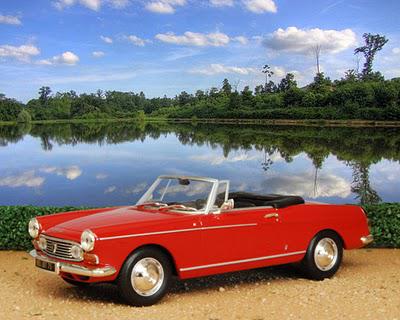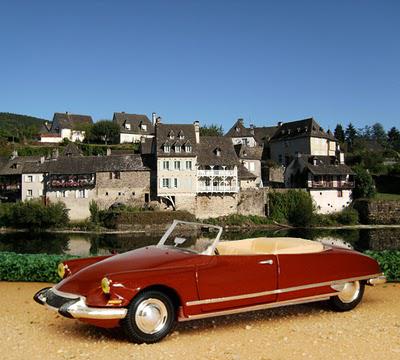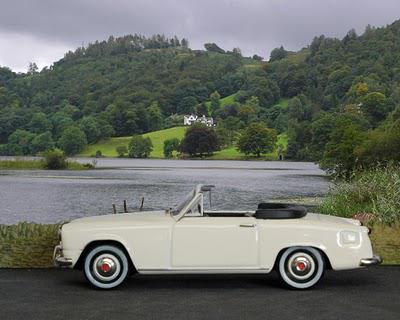
Peugeot 404 Cabriolet (the model is a 1:43 by Minichamps). There were no 404 cabriolets
to be seen here when I was cruising around in 404 sedans, wagons and light trucks in the
70s and 80s in Australia. I even contemplated jumping on a plane and flying on a 'French car
fan's holiday' to Noumea in nearby French-governed New Caledonia, just so I could check
out some 404 cabriolets and hopefully, by then, the sleek new 504 cabriolets too, if the
French colonies had any yet. When I finally spent some time in France in the mid 1980s,
404 cabriolets were quite rare things, but I did manage to see a few in the flesh. And
very nice Pininfarina bodies they are too.

Citroen DS19 cabriolet, pictured in a picnic spot by the edge of the Dordogne River. This
model is a nice old one by Norev, with a plain metal underside stamped with its details.
This Norev model is also something of a record-holder for me. It's the car which has taken the
longest to arrive via the postal system from anywhere. Bought on eBay on September 28,
posted to me in Germany the next morning, then arriving 69 days later, on December 9.
Moral of the story: never give up hoping!

Though I have featured the Peugeot 203 Cabriolet on earlier blog postings, it just couldn't
miss out on a spot in this French cabriolet celebration. Here, it is also pictured on the pretty
Dordogne River, crossing a bridge on the way meet up with this friend in the Citroen DS19.

Last of the dioramas is this Simca Aronde Convertible from 1955, marketed as the 'Weekend'
according to Altaya, who makes this model. It, too has stopped for a picnic,
but I don't like the look of those clouds looming on the horizon.
The Simcas I was most familiar with in the 60s and 70s were the four-door hardtop versions of this cabriolet, the Arondes (also around were bigger cars, the Arianes, but not as plentiful as the Arondes). Simcas were actually assembled in Australia for several years, up to 1964, and they had a good following here as a result. The Aronde was nothing to get excited about technically. A small engine (1221cc OHV straight four); independent coil front suspension and live-rear-axle/leaf spring rear suspension. Top speed 74mph (119k).
Simca, as a company, had an odd history. For one thing it started as an offshoot of Fiat, in the 1930s, in the beginning just assembling (in France) Fiat cars and putting Simca badges on them. After the Second World War they started designing and making their own French cars, and they were good solid cars, so good that at times certain models were the best-selling cars in France. But Simca was never its own company. It was mostly owned by Fiat, part-owned by Ford, who sold their share to Chrysler, who then took it over, who then sold it to Peugeot-Citroen PSA, who then dumped the Simca name altogether and replaced it with the Talbot name. So, it's hardly a glorious history for a maker of good, popular cars, and a story I didn't know at all well until I bought this nice little white cabriolet.
Instead of finishing on that down note, let's go cruising in a stylish French cabriolet for half a minute or so, just to remember that life is a picnic (or at least seems like you're going to a picnic) when you're in a cabriolet with the top down, and the sun is shining.
